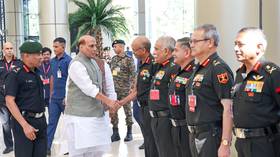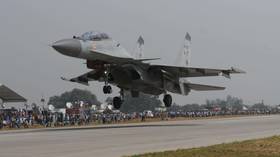India should ‘expect the unexpected’ – defense minister

Indian defense minister Rajnath Singh has warned that the country’s armed forces should be prepared to face “unconventional and asymmetric warfare, including hybrid war” as both will form a part of conventional warfare in the future.
This should factor into the military’s planning and formulation of strategy, he said during an address to the Indian Army’s senior leadership on Wednesday.
“We must keep learning from the incidents to include the global ones, happened in present as also in past. Expect the unexpected and thereby plan, strategize and prepare accordingly,” Singh said during the Army Commanders’ Conference in New Delhi, according to a government statement.
The comments came against the backdrop of the unfolding conflict in the Middle East after Hamas launched a deadly attack on Israel on October 7, prompting Israel to retaliate against Hamas-controlled Gaza, as well as in the context of the Ukraine conflict.
India is said to be tracking these events closely to keep its military updated on modern warfare tactics, Hindustan Times reported. The escalation between Israel and Palestine was also discussed during Wednesday’s high-level meeting, unnamed Indian officials informed the outlet.
“War preparedness should be a continuous phenomenon,” Singh advised in his speech, underlining that India should always be ready for the “unpredictable” due to “uncertainties that may crop up.” He encouraged the army to continue strengthening its fighting skills and weapons technologies “to act effectively wherever called upon.”
The minister also pointed to technological advancements affecting all aspects of life and applauded the military for masterfully incorporating them. He appreciated the army’s efforts to develop niche technologies in collaboration with civil industries and noted that the government was focusing on modernizing India’s defense by boosting domestic manufacturing.
Singh’s comments came weeks after India’s defense ministry approved a $5.4 billion spending package, which covers various weaponry and ammunition, including survey vessels for the navy, Dhruvastra short-range air-to-surface missiles for the air force, Light Armored Multipurpose Vehicles (LAMV), Integrated Surveillance and Targeting Systems (ISAT-S), and a dozen Russian-designed Sukhoi Su-30 MKI fighter jets that will be built under license for the Indian Air Force by Hindustan Aeronautics Limited (HAL). A recent Indian government study also recommended procuring 31 MQ-9Bs drones and 155 Medium Altitude Long Endurance (MALE) drones to be used both by the Indian Air Force and Army.
Weighing in on India’s tensions with China along the Line of Actual Control (LAC) in Ladakh, Singh said that “talks for peaceful resolution will continue.” He also expressed faith in Indian troops to “deal with any contingency,” should the need arise.
Recently, India and China held a 20th round of corps commander-level talks on October 9-10 as part of efforts towards disengagement and de-escalation along the contested border. There was no clear indication of any breakthroughs, however. While the two sides disengaged from the Gogra-Hotsprings border area in the western Himalayas in 2022 following extensive diplomatic and military talks, friction points remain.












